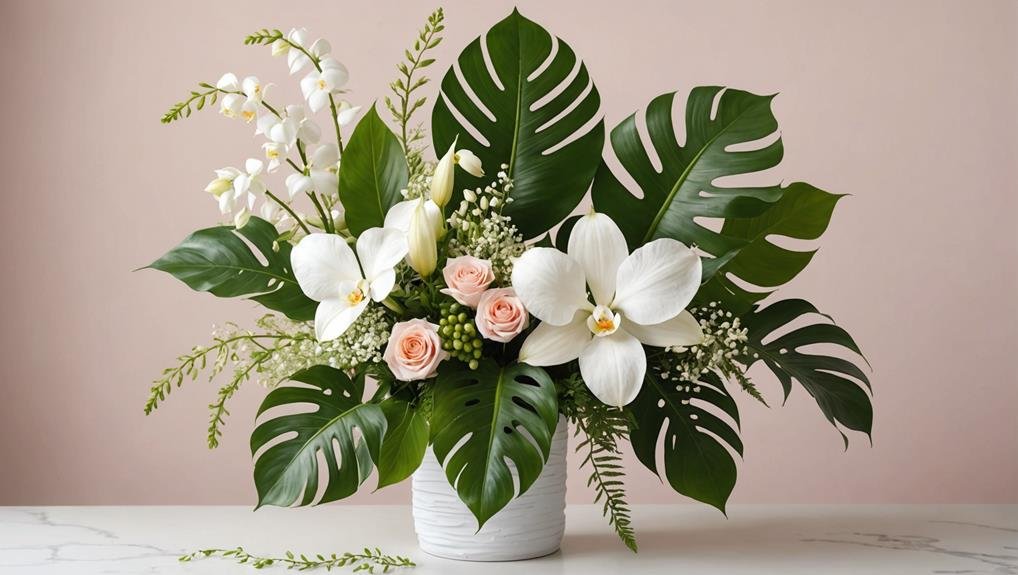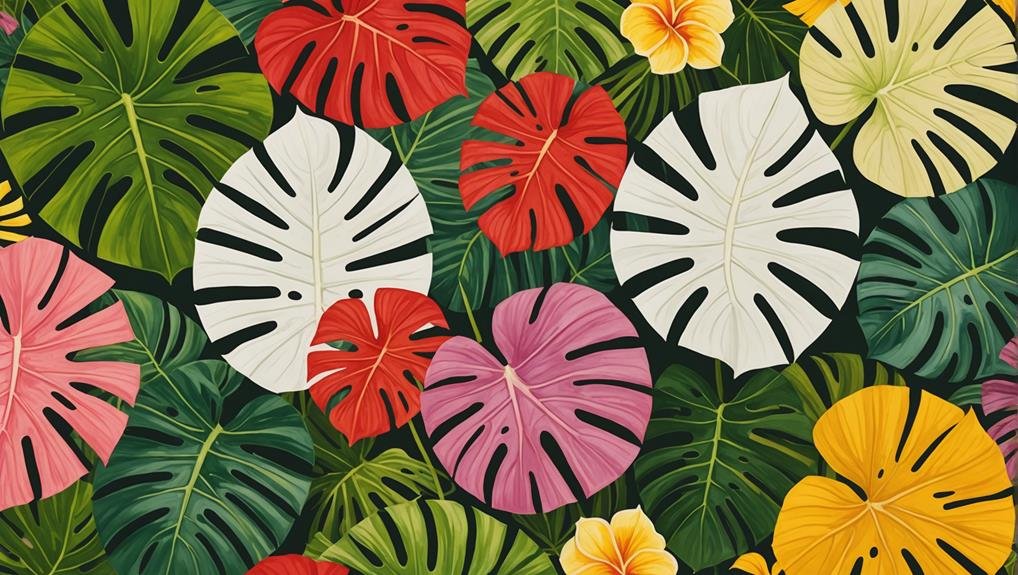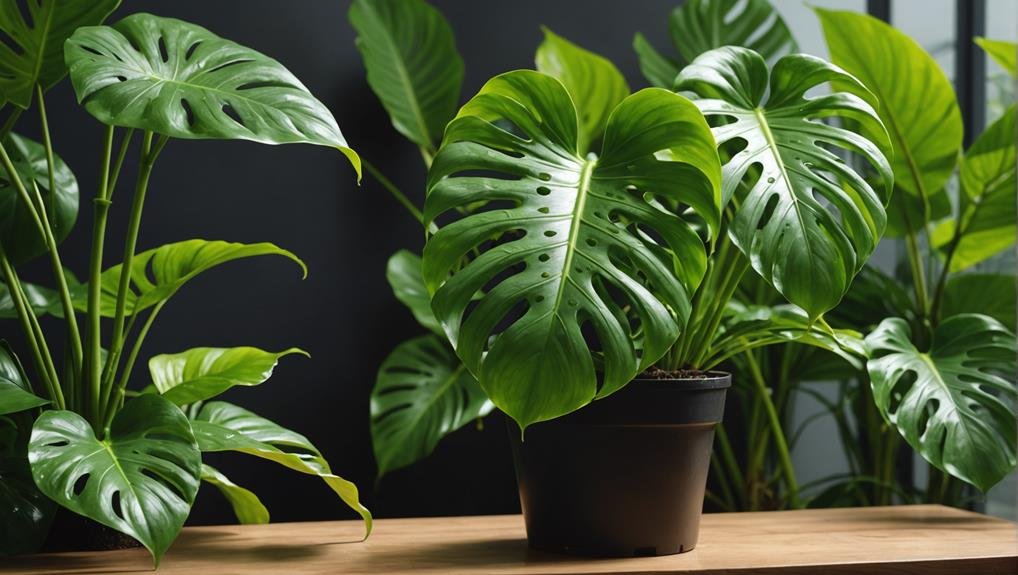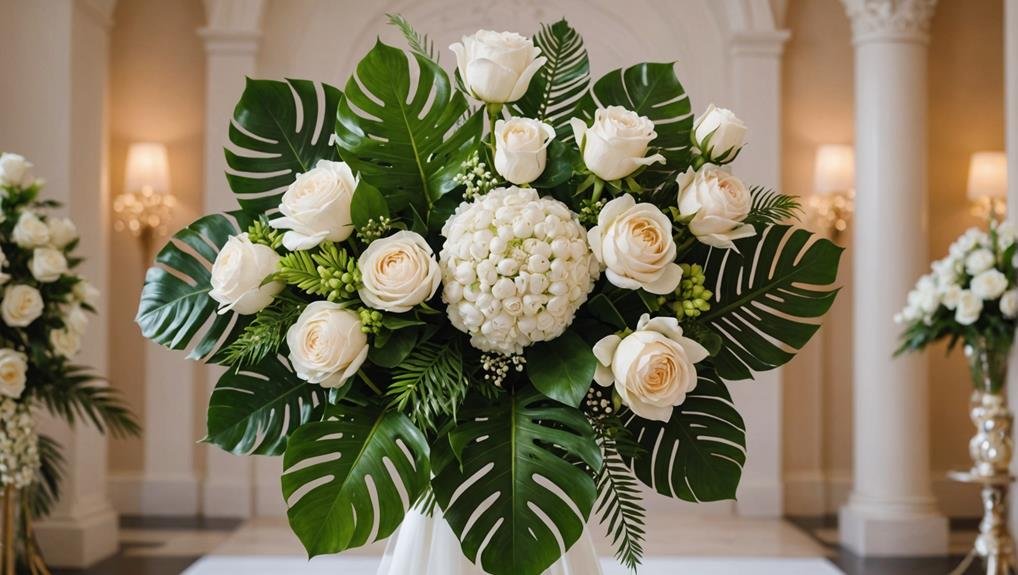Monstera leaves, known for their strikingly large, glossy foliage, have become a distinguished element in wedding floral arrangements, epitomizing prosperity and good fortune. Their versatility, available in various sizes and year-round, makes them an ideal choice for any wedding theme or season. The lush greenery and sophisticated aesthetic they offer can transform bouquets and centerpieces into vivid displays of natural elegance. What makes Monstera leaves particularly compelling, however, extends beyond their visual appeal. Let's explore how their cultural significance and practical benefits can elevate your wedding decor to the next level.
Flower Overview

Monstera leaves, known for their tropical and exotic appearance, are a striking addition to wedding flower arrangements. Their unique aesthetic makes them a popular choice among floral designers looking to infuse a sense of lush greenery and sophistication into their creations.
Available in various sizes, Monstera leaves can be sourced from wholesale flower markets, typically in bunches of 10 or 20 stems. These markets often offer leaves in dimensions such as Small (40cm), Medium (50cm), and Large (60cm), catering to diverse design needs.
When purchasing Monstera leaves, proper handling and conditioning are essential to guarantee their longevity and visual appeal. It is recommended to cut the stems at a 45-degree angle to maximize water absorption. Additionally, conditioning the leaves overnight in a cool, water-filled environment helps to sustain their freshness and durability. This process is particularly important for maintaining the structural integrity and vibrant green color that Monstera leaves are renowned for.
Physical Description
Renowned for their large, glossy, and deeply lobed leaves, these tropical plants exhibit a distinctive aesthetic with holes that develop as the foliage matures. Monstera leaves, native to Mexico and belonging to the Arum family, are celebrated for their exotic appearance and have become a staple in wedding flower arrangements. Their unique patterns and textures add a touch of sophistication and natural beauty to any floral display.
In the wholesale flower markets, Monstera leaves are available in various sizes, typically ranging from Small (40cm) to Large (60cm). They are sold in bunches of 10 or 20 stems, making them a convenient and cost-effective option for florists and event planners. Purchasing Monstera leaves from Web-Shops also allows for easy access to these stunning foliage pieces.
Proper handling of Monstera leaves is essential to maintain their freshness and vibrancy. It is recommended to cut the stems at a 45-degree angle and condition them overnight in lukewarm water with flower food. Additionally, storing Monstera leaves away from direct sunlight, drafts, and fruit gas exposure guarantees their longevity.
Their symbolic meaning of prosperity and good fortune further enhances their appeal in wedding flower arrangements and DIY projects.
Available Colour Varieties

Although Monstera plants are mainly known for their striking dark green foliage, several color variations exist that can enhance their visual appeal in floral arrangements. These variations, although rare, offer unique options for florists and DIY floral enthusiasts looking to create distinctive and memorable wedding designs.
One notable variation is the variegated Monstera, which features leaves with patches or streaks of white, cream, or light green. These variegated leaves can add a dramatic contrast and an element of surprise to any floral arrangement.
Additionally, the Monstera 'Albo-Variegata' and 'Thai Constellation' are sought after for their unique patterns and coloration, making them prized choices in both retail and wholesale flowers markets.
Florists and event planners can access these color varieties through specialized wholesale flower suppliers, often available in bunches of 10 or 20 stems. This availability guarantees that even larger-scale events can be adorned with these exotic leaves.
Whether integrated into a sophisticated centerpiece or used as a backdrop in wedding arches, the various color options of Monstera leaves provide versatility and an added layer of elegance to wedding floral designs.
Latin Name and Taxonomy
Beyond its array of enchanting color variations, the Monstera plant is scientifically recognized as Monstera deliciosa, belonging to the Araceae family. Known for its striking foliage, the Latin name Monstera deliciosa is derived from the plant's impressive size and the 'delicious' fruit it produces. The term 'Monstera' hints at the monstrous size the plant can achieve, while 'deliciosa' refers to the sweet, edible fruit that is a notable feature of mature specimens.
In terms of taxonomy, Monstera deliciosa resides within the Araceae family, a diverse group that includes other popular ornamental plants such as the Philodendron and Anthurium. The Araceae family is characterized by its flowering plants, which often possess a distinctive spadix and spathe structure. Monstera deliciosa, with its large, glossy leaves dotted with natural perforations and lobes, is a prime example of the family's unique botanical traits.
Additionally, Monstera deliciosa is known by various common names, including the Swiss Cheese Plant and Mexican Bread Fruit. These names highlight its distinctive leaf patterns and the fruit's culinary uses. Understanding the Latin name and taxonomy of Monstera deliciosa provides valuable insights into its botanical classification and cultural significance.
Geographical Origins

Monstera deliciosa, indigenous to the tropical rainforests of southern Mexico and Central America, thrives in humid, shaded environments. This plant is a member of the Arum family, known for its distinctive large, glossy leaves that develop characteristic holes and lobes as they mature. The Monstera, often referred to by various names such as Swiss Cheese Plant, Ceriman, and Fruit Salad Plant, plays a significant role in its native regions.
In Peru, the aerial roots of the Monstera are creatively utilized to make ropes, showcasing a practical DIY approach inherent to the local culture. Likewise, in Mexico, these roots are fashioned into baskets, demonstrating the resourcefulness and traditional craftsmanship that deliver essential goods to communities. These uses highlight how the plant has always been an integral part of daily life in its native habitat.
Understanding the geographical origins of Monstera plants not only enriches our appreciation for their beauty but also underscores their versatility and cultural significance. Incorporating Monstera into wedding decor can be inspired by these traditional uses, adding a touch of authenticity and natural elegance to any celebration.
This plant, with its rich history and multifaceted utility, continues to captivate and inspire.
Season Availability
Tropical and evergreen, Monstera leaves are accessible throughout the year, making them an adaptable choice for wedding floral arrangements. Their year-round presence guarantees that couples can incorporate these distinctive leaves into their wedding decor, irrespective of the season.
Whether planning a spring garden party or a winter wonderland wedding, Monstera leaves provide a consistent and dependable option for enhancing floral displays.
Monstera leaves' vibrant green hues are particularly popular for spring and summer weddings, adding a touch of tropical elegance to the festivities. Their continual presence in wholesale flower markets assures that wedding florists can easily obtain these leaves, regardless of the time of year.
For DIY brides, Monstera leaves also offer a practical solution, as they can be readily purchased from online suppliers and local flower vendors.
The versatility of Monstera leaves allows them to complement a variety of wedding themes and styles, from chic and modern to rustic and bohemian. Their steady seasonal availability means that couples do not need to fret about their wedding arrangements being impacted by the changing seasons.
This dependability makes Monstera leaves an excellent choice for any wedding, providing a lush, green backdrop for unforgettable celebrations.
Growing Conditions

Optimal growing conditions for Monstera plants include indirect sunlight and temperatures ranging between 65-85°F. These conditions closely resemble their natural tropical habitat, allowing them to thrive. Monstera plants prefer a location where they receive bright, filtered light rather than direct sunlight, which can damage their leaves. Placing them near a window with sheer curtains or in a well-lit room is ideal.
Maintaining proper humidity levels is also vital. Monstera plants flourish in environments with humidity levels of 50-60%. To achieve this, consider regular misting or placing a humidifier nearby, especially during drier months. This practice helps replicate the moist conditions of their native rainforests.
Regular watering is necessary for Monstera plants. They thrive in well-draining soil, and it is important to allow the soil to partially dry out between waterings to prevent root rot. Typically, watering once a week is adequate, but this can vary depending on the specific environment and season.
Additionally, occasional pruning is advantageous. Pruning not only promotes healthy growth but also helps maintain a desirable shape, making the plant more visually appealing.
Cultural Significance
Beyond their ideal growing conditions, the cultural significance of Monstera leaves adds another layer to their appeal, particularly in wedding decor. Known for their large, glossy texture and unique split patterns, Monstera leaves are more than just an exotic addition to floral arrangements; they are symbols of prosperity and good fortune in various cultures. This symbolism makes them an ideal choice for couples looking to infuse their special day with deeper meaning.
In many tropical regions, Monstera leaves are believed to bring positive energy and blessings to those who incorporate them into their celebrations. The vibrant green color and exotic appearance of these leaves enhance the aesthetic appeal while embodying a sense of abundance and growth. This cultural significance aligns perfectly with the themes of unity and prosperity often celebrated in weddings.
Moreover, the versatility of Monstera leaves allows them to be easily integrated into various DIY projects, making them a favorite among wedding planners and decorators. Whether used in bouquets, centerpieces, or as standalone elements, the Monstera leaf's cultural resonance and striking visual appeal make it a compelling choice for any wedding setting.
Typical Use in Weddings

Monstera leaves are frequently chosen for wedding decor due to their ability to impart a sophisticated and exotic ambiance to floral arrangements. Their large, glossy leaves provide a striking visual contrast that enhances the overall aesthetic of wedding flower arrangements. This dramatic foliage is often incorporated into various elements of wedding decor, including bouquets, centerpieces, and general floral decor.
In bouquets, Monstera leaves add texture and depth, making them a popular choice for brides seeking a unique and stylish look. Their bold appearance pairs well with a variety of flowers, from delicate roses to vibrant orchids, creating a balanced and visually appealing arrangement.
For centerpieces, Monstera leaves serve as an elegant base that complements a range of floral designs. Their broad leaves can frame flowers beautifully, adding a lush, tropical feel to the table settings. Additionally, Monstera leaves are versatile in floral decor, whether used alone for a minimalist touch or combined with other greenery for a more abundant effect.
Symbolizing prosperity and good fortune, Monstera leaves are an ideal choice for wedding celebrations. Available in various sizes and typically sold in bunches, they are easy to source and handle, ensuring their prominence in wedding flower arrangements.
Alternative Flower Types
When planning wedding floral arrangements, considering alternative flower types can be important for maintaining aesthetic consistency and quality. Florists and DIY floral enthusiasts often need to sub in a similar bloom when the original choice is unavailable, incorrectly colored, or in poor condition. Working with live product means that unpredictability is part of the process, making knowledge of suitable replacements invaluable.
A well-thought-out replacement strategy involves choosing flowers that match the original in color, shape, and price-point. For example, if peonies are unavailable, garden roses can serve as a beautiful and comparable alternative. This ensures the overall look of the arrangement remains cohesive and maintains the desired aesthetic. Florists often have a video on Flower Substitutions to guide customers through these choices, highlighting the importance of flexibility and adaptability in floral design.
Whether you are a professional florist or undertaking a DIY floral project, understanding and utilizing alternative flower types is important. This practice not only upholds the quality of the arrangements but also allows for creative solutions when faced with unforeseen challenges. Embracing the art of replacement ensures that every wedding arrangement is as stunning and harmonious as envisioned.
